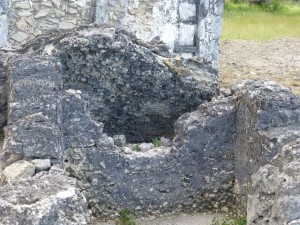Monday, December 17th, 2012 Bagamayo, Tanzania
Before leaving San Francisco a colleague at the San Francisco Opera gave me an introduction to Brett Wesner. He and his partner who works on the Aids Project find themselves frequently in Dar es Salaam. Brett gave me wonderful advice and travel tips. One of the latter was an encouragement to add Bagamoyo to my touring list. Located about an hour outside Dar es Salaam he thought I would find interesting the remains of a 13th Century mosque which had beautiful shells.
I shared my desire to visit this site with Dorah and Paulyn. Within an hour Dorah’s brother appeared at the apartment enthusiastically telling me about the wonderful Bagamoyo College of the Arts. He was a recent graduate and now had his own media company. Obviously his training had been excellent. My whistle was really wetted. The girls and I decided we would go on Monday following the wedding. Sunday night Todo called. I shared our Bagamayo plans. Neither she nor Rube had been. We decided to join up. Todo & Rube lived enroute so we planned to connect with them via cell phone.The girls and I were up early. Thankfully, Pere took us to a bus terminal, a mad collection of more than 30 buses, parked higgly, squiggly. (no platforms). Never mind, Dorah to the rescue. She found our bus on the far side. We were the second group of passengers aboard enabling us to move to the back and settle in. This was milk run – many stops, along with interesting country side.
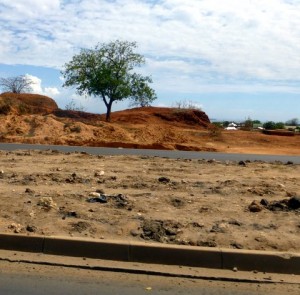
I was amazed that the police wear white uniforms. Yes, they are distinctive but with so much red soil….

Paulyn’s cell phone went. Todo and Rube were on the highway awaiting us at our next stop – which we reached in two minutes. Talk about coordination. A gay and jolly fivesome we were. All four of them filling me with Tanzanian info, like coconut trees. Their life span is about 50 years. When their time to stop producing fruit is reached the tops of the trees no longer produce green leaves and thus no coconuts. The trees become sticks waving in the air. Quite odd!
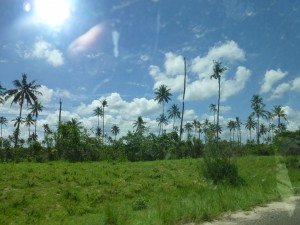

Dorah encouraged us to start at the Bagamoyo College of the Arts. We were thrilled with what we saw. A very beautiful theater designed, I am told, by Scandinavian architects, appeared before us. Dora checked with the officials to see if we could have a tour. Yes, not only could we but also they offered a third year design student, Godfrey Elias, to take us through the complex. As this is a government building we were not allowed to take pictures. Too bad!
While the theater is enclosed, it cascades down a hill making a raked seating arrangement for about 300 possible. Standing on the stage I felt like I was in a Greek Theater, with the large flat “pit” in front of the stage. Yes, the building is enclosed, but it is not air tight. Rather there is a metal framework to hold many windows and create open space. The center has rehearsal halls, a media center, dressing rooms etc in addition to the theater. Separate is aa conference center and dormitories for all of the students. It must be wonderful to study there.
We asked Godfrey if he wanted to continue with us. To our delight, yes. We walked to the beach just below the College of the Arts discovering, a long white sandy beach, with boats in the distance.

As we wandered down the beach I learned the town of Bagamoyo, Tanzania, was founded at the end of the 18th century. It was the original capital of German East Africa and was one of the most important trading ports along the East African coast. Further, it was the primary port for transporting slaves from Tanzania to the Zanzibar as well as on to Arab countries. As we walked we passed by one of the holding spots for slaves.
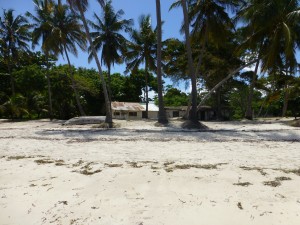
As we continued we saw the remains of large structures where slaves were held. Later they were used by the Germans to protect themselves during World War I.

The structures were made out of stone and secured by dirt. To us it seemed astonishing.
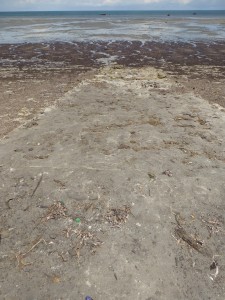
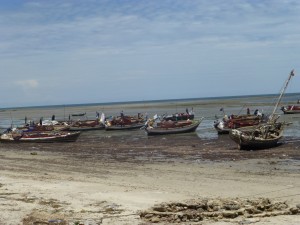
Godfrey also told us that these small boats are still used today to ship 10 cows per boat to Zanzibar which is about three hours away (in a small boat.)
It turns out that Bagamoyo has a colorful past. In the late 17th and 18th Centure the Omani Arabs and Indian merchants made Bagamoyo a trade center. When the Brits colonized, their caravan porters and their leaders shipped their wares (ivory, ebony, spices etc). from Bagamoyo. Then the Germans came along.
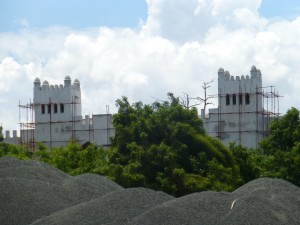
As we moved into the center of Bagamoyo, leaving behind the beach we discovered small houses with amazingly beautiful hand-carved wooden door frames. Seems they are of both Arabian and Indian designs.
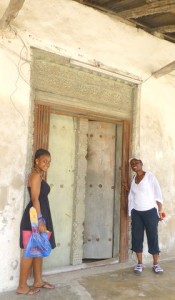
This building below was a slave market – used to process the slaves. It has turned been turned into an immense arts and crafts market creating, making and selling paintings, carvings, sculpture, batiks, crocheted hats and bags, necklaces, bracelets, traditional drums, and various other musical instruments. They also deal with traditional dance, music, performance, designing, and models.
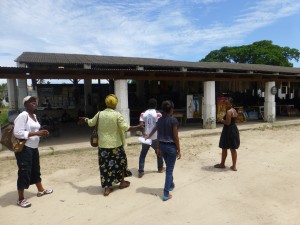

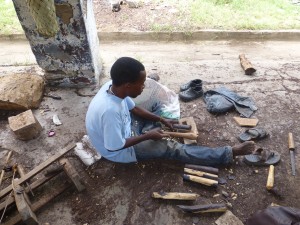
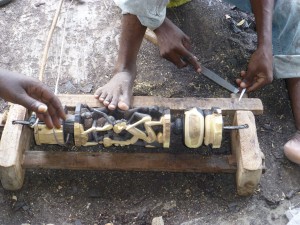
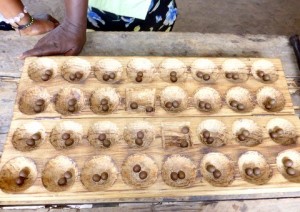

We begin to wander again and come upon a museum.
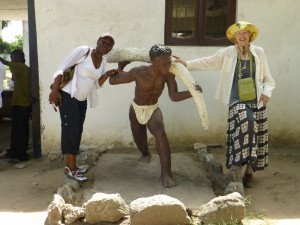
It’s pm we were starved. Godfrey to our rescue. He knew of a restaurant that had recently opened. By the way, the man in the picture above is a statue!

At lunch we relaxed. It’s hot out there, 95 degrees.

Betwee mouthfulls I took this picture of the decorative braiding that Paulyn had done for the wedding on Saturday.

I asked if it hurt when braided. Yes, she said, but not too much. Hmm, I am not sure I would want that!
Lunch over, we wandered back to the Bagamoyo College of the Arts – about a mile. In the doing we passed:

I read somewhere that Bagamoyo is being considered as a heritage town. I vote for that. As we continued meandering Todo’s eye caught this:

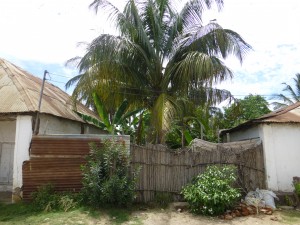
We leave old town behind us and venture through lots of trees.

- It’s mango season!

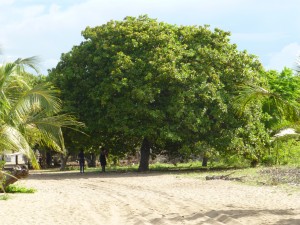

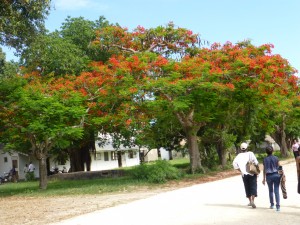
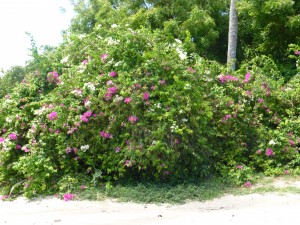
Now, we have reached the College of the Arts and said good by to Godfrey. Dorah is wanting us to move along for we have two more stops: A crockodile farm and Kaole. Turning left we venture into a dirt road that is under construction. Ohhhh, all we could do was laugh. The holes were deep, it felt like there was room only for one car in one direction, but, of course, cars and even trucks needed to pass from the other direction. Our driver, Todo, is fearless. At one point we hung dangerously on a cliff – but it all worked.
About 4 miles down the road a sign indicated we had arrived at the crockodile farm. Turning in, we saw a small house with a few people hanging around. One was selling jewellry that caught my eye. Then, a guide took us to the breeding location.
We peered over the walls:
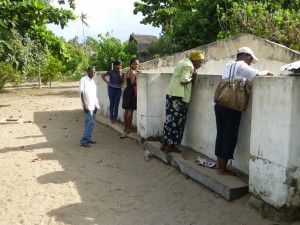
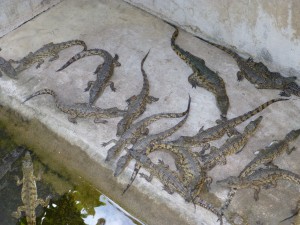

There was also an amazing tree (don’t know name) with unusual nests.

The birds are tiny and they never stay still. I took a ton of photos and only caught one.

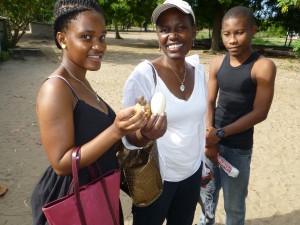
It’s time to move on. Out onto the bumpy road we go to continue to the Kaole Ruins. It was about 4 pm and the tour guides weren’t sure they would let us in. We persisted.Given Kaole’s date of construction, beginning in the 13th Century, it is a rather large settlement. There are the remains of 30 tombs, 2 mosques and other structures : I was intent in finding the deposit of shells that Brett had mentioned.
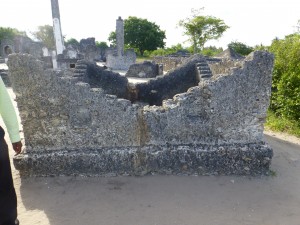
It is thought that the local sultans and their descendants were buried in these tombs. The tombs and other structures look somewhat effervescent.
We also saw remains/elements of two mosques.
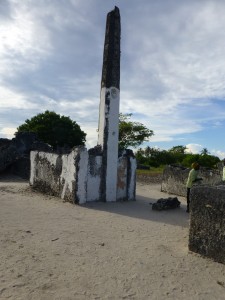
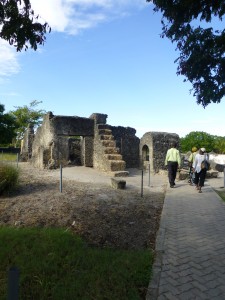
The guide then walked us towards the Indian Ocean. We didn’t get there because a couple of centuries ago trees began to grow near the ocean shore and the inhabitants didn’t choose to cut them down. The port that had once been quite active moved.
It never occurred to me that I was not going to find the shells as a separate entity. (Brett replied to an e-mail I sent explaining the shells weren’t separate but part of the construction materials.) Silly me, that was why the remains are so effervescent and beautiful.
It was now 5 pm and time to head back to Dar es Salaam. A very rich day.
Enroute we stopped and picked up goodies:
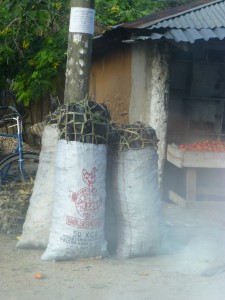

Our trunk was so loaded with goodies that we knew Todo could not drive us into Dar with all the pot holes. The car was sitting too close to the ground. A stop is planned at Todo’s house. Rube claimed she wanted to drive. We all gasped for she lives in San Francisco and not used to left side driving. However, the highway road was straight and we made it safely to Todo’s, unloaded and then Todo took the wheel and we headed for town. I had NO interest in driving in Tanzania. Left side driving would not be my most favorite thing to do.

As we are driving back into Dar we decide that Wednesday, day after tomorrow, we will go to Zanzibar. I share that Brett Wesner has given me a lead to a Bed & Breakfast in Zanzibar. I will e-mail to night to see if they have space in such short notice.
Monday, December 17th, 2012 Bagamayo, Tanzania Read More »

